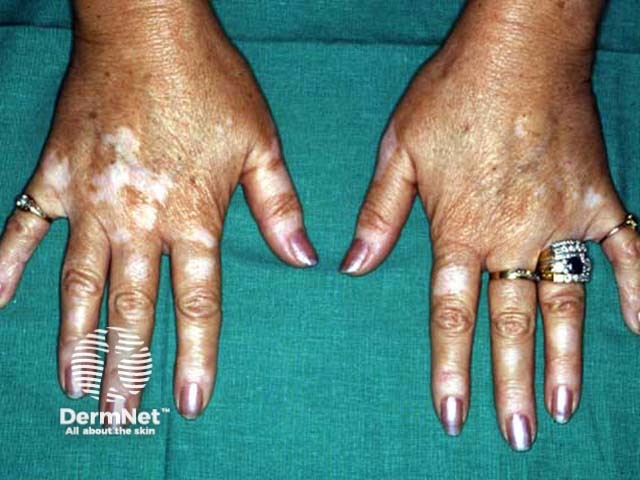Main menu
Common skin conditions

NEWS
Join DermNet PRO
Read more
Quick links
For each of the ten cases, study the image(s) and then answer the questions. You can click on the image to view a larger version if required.
Each case should take approximately five minutes to complete. There is a list of suggested further reading material at the end of the quiz.
When you finish the quiz, you can download a certificate.

What is the likely diagnosis?
Vitiligo. Circumscribed areas of hypopigmented skin arise because of selective destruction of melanocytes, but the mechanism is unknown. There is a family predisposition to vitiligo and it is associated with diabetes, thyroid disease and other autoimmune conditions. When vitiligo affects the dorsum of the hands and finger, hypopigmented macules may also be found on the face or more generally.
Is there any other possible explanation?
Leucoderma on the hands may be postinflammatory (e.g. following thermal burns or contact dermatitis) or may be due to occupational exposure to phenolic compounds or monobenzyl ether of hydroquinone.
What treatment is available?
Careful sun protection is generally advised, to reduce the risk of solar keratoses and skin cancer arising in the affected areas, and to improve the appearance by minimising the contrast between vitiliginous and normal skin. However, paradoxically, ultraviolet radiation can stimulate repigmentation. Dermatologists in main centres may recommend phototherapy (narrowband UVB) or photochemotherapy (PUVA). Treatment is required two or three times weekly for one to two years. Vitiligo affecting distal phalanges rarely improves. Potent topical steroids can prove effective if applied to new areas of vitiligo for courses of six weeks or so, but risk causing cutaneous atrophy. Surgical transplants of normal skin have been used successfully in stable vitiligo but are not generally performed in New Zealand. Cosmetic camouflage may be useful, particularly for facial vitiligo.